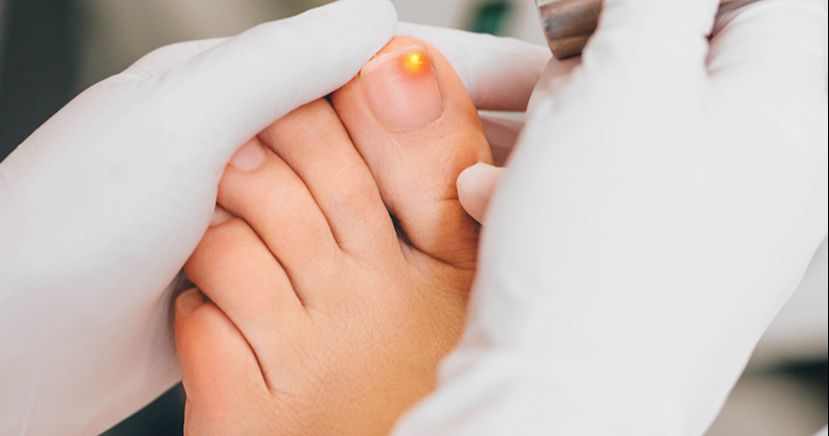Laser Therapy for Fungal Infections
Onychomycosis is a fungal nail infection. It is the most common nail disease and accounts for about half of all nail abnormalities. It is estimated to affect nearly 10% of the general population, and appears in almost 30% of individuals over 60 years old. It more frequently occurs on toenails, most commonly on the big toenail. Signs and symptoms of nail fungus include thickened, yellowish-colored nails, crumbly or brittle nails, loss of nail shine, unpleasant odor from the nail bed, and white spots on the nails.

Treatment
Laser fungal removal works by the low energy density of a specific wavelength thermally heating the nail tissue. When the tissue can no longer bear the heat, the proteins in the nail coagulate. Next, water within the nail quickly evaporates. This achieves fragmentation and the destruction of the fungi. Unlike the partial effectiveness and various side effects of orally applied medications for fungal eradication, laser treatment is the therapy of choice for destroying nail fungi. It provides excellent results with deep penetration, ensuring effective treatment without affecting the surrounding tissue. During the procedure, the pathogens causing nail fungi are specifically destroyed, allowing the new healthy nail to grow uninterrupted. The process is completely safe and painless. It is essential to remove the nail polish a day before the procedure.
Results
The outcome of the treatment can be achieved with one or two treatments spaced one and a half to two months apart, but this depends on the severity of the fungal infection. Therefore, the outcome, the growth of new clear nail structures, is not immediately visible. However, about 6 – 8 weeks after the initial treatment, the first newly formed transparent nail structures are noticed. If this isn’t the case, an additional treatment can be performed. A third treatment, if needed, is done 6 – 8 weeks after the second treatment. The final result should be visible within 9 months to a year since nails, especially on the feet, grow slowly.
Candidates
Candidates are all individuals suffering from nail fungi and wish to permanently and painlessly get rid of them. Unlike other treatment modalities for fungi, the laser has no severe side effects and is an excellent alternative for many patients who cannot or do not wish to take oral medications. Laser treatment is not recommended for pregnant women, people under 18, those suffering from epilepsy, and patients with an active tumor.
Recovery
Most people describe the procedure as comfortable, with a feeling of warmth and heating in the treated nail. Immediately after the procedure, the nail may be warm to the touch. However, possible side effects can include a sense of warmth and/or slight pain after treatment, redness of the treated skin around the nail lasting 24 – 72 hours, slight swelling of the treated skin around the nail for 24 – 72 hours, and color changes on the nail. In very rare cases, blisters can appear on the skin around the treated nail. Most patients can resume normal activities immediately. In the long run, if the treatment is successful, as the nail starts to grow, you’ll see the emergence of a new, healthy nail. To avoid infecting adjacent nails, the patient can use antifungal creams, polishes, or sprays after the laser treatment. We particularly recommend the Footlogix spray based on the antifungal clotrimazole, which is advisable to apply in the morning and evening to the affected nails.